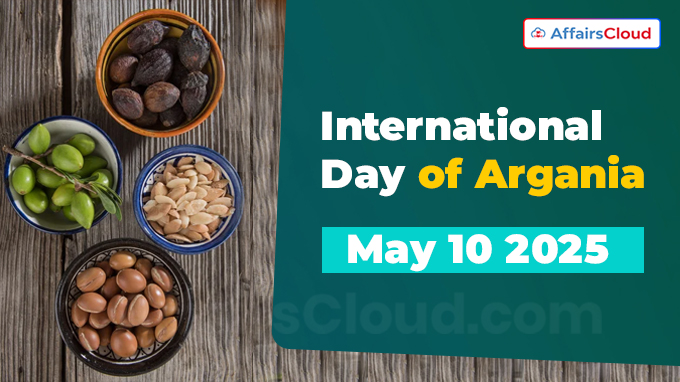 The United Nations (UN’s) International Day of Argania is annually observed across the globe on May 10 to create awareness and promote the major role of the Argan tree (Argania Spinosa), a native species of the sub-Saharan region of Morocco, which grows in arid and semi-arid areas.
The United Nations (UN’s) International Day of Argania is annually observed across the globe on May 10 to create awareness and promote the major role of the Argan tree (Argania Spinosa), a native species of the sub-Saharan region of Morocco, which grows in arid and semi-arid areas.
- The day highlights Morocco’s dedication to elevate the Argan tree as a symbol of heritage and a source of resilient and sustainable development.
- 10th May 2025 marks the observance of 5th International Day of Argania.
Theme:
The theme of International Day of Argania 2025 is “The Argan Tree Conservation”.
- The 2025 theme aims to highlight the role of the Argania tree in strengthening sustainable development and environmental conservation efforts.
Background:
i.In 2021, the United Nations General Assembly (UNGA) adopted a resolution A/RES/75/262 and proclaimed the 10th May of every year as the International Day of Argania.
ii.The resolution, submitted by Morocco, was co-sponsored by 113 member states of the United Nations and adopted by consensus.
iii.The first ever International Day of Argania was celebrated on 10 May 2021.
Key Objectives:
i.To promote a greater understanding of the Argan ecosystem and species response to climate change and its potential contributions to mitigation and adaptation.
ii.To highlight the importance of its preservation, this serves as a cornerstone for cultivating sustainable practices that enhance the long-term well-being of both the environment and communities dependent on the argan tree.
iii.To promote the adaptation of biodiversity preservation and climate change mitigation policies that integrate the protection of the argan tree.
iv.To Strengthen international partnerships and promote cooperation to support initiatives for the conservation of the argan forest.
About Argan Tree:
i.The Argan tree is the defining species of a woodland ecosystem, also known as Arganeraie, which is rich in endemic flora.
- It is resilient to harsh environments under water scarcity, risk of erosion and poor soils.
ii.The Argan tree woodlands provide forest products, fruit and fodder, constituting a vital fodder reserve for all herds, even in periods of drought.
- The leaves and the fruits are edible, and the trees are also used as fuel wood for cooking and heating.
- The world-renowned argan oil is extracted from seeds and has multiple applications, especially in traditional and complementary medicine and in the culinary and cosmetic industries.
iii.The sustainable argan production sector contributes to the economic empowerment and financial inclusion of local communities, especially rural areas.
iv.The argan tree withstands temperatures of up to 50 degrees Celsius(°C) .
v.In 2014, UNESCO inscribed “Argan, practices and know-how concerning the argan tree” on the Representative List of the Intangible Cultural Heritage of Humanity.
Note: Argan oil is one of the rarest oils in the world and is hailed as “liquid gold” of Morocco. It takes about 150 kilograms (kg) of fruit to produce 3 litres of argan oil.




